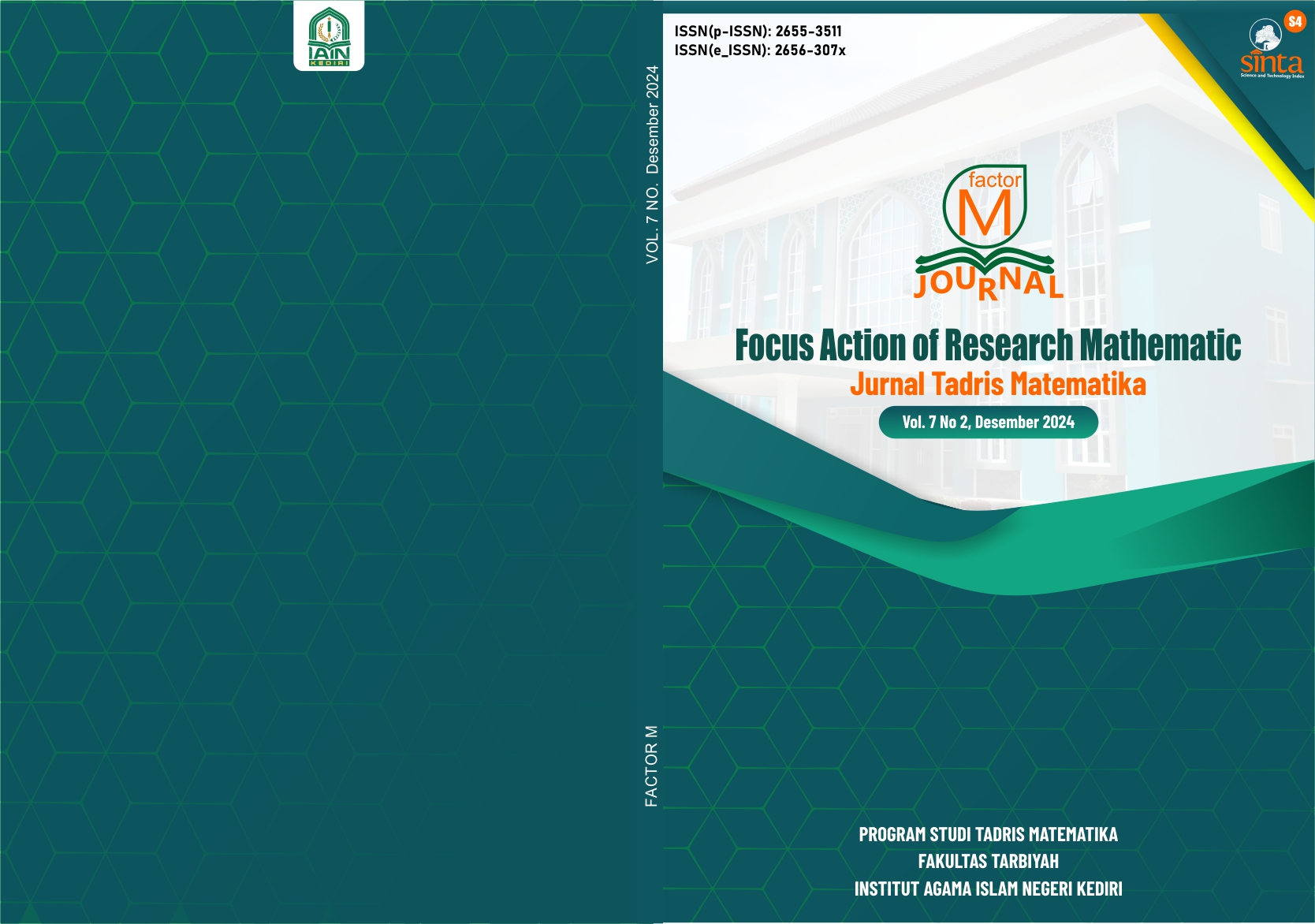Analysis of students' dual processes in solving number pattern questions and providing scaffolding
DOI:
https://doi.org/10.30762/f_m.v7i2.3499Keywords:
Dual-Process Theory, Number Pattern, ScaffoldingAbstract
This research aims to describe students' dual-process in solving number pattern questions and scaffolding that support students' dual-process. This research uses a qualitative research approach with a case study type. The subjects of this research were two 10th grade high school students. The subjects' written answers, recorded interviews, and researcher notes were used as the basis to analyze the subjects' dual-process and scaffolding. There are three findings from this research. First, subjects tend to activate mental processes that are automatic, subjective-empirical, and often occur unconsciously in solving number pattern questions. Second, errors occur due to the subject's tendency towards one of the mental processes which are automatic, subjective-empirical, and often occur unconsciously. Third, scaffolding in the form of questions and instructions by the researcher supports the activeness of the subject's mental processes which are empirically accurate and involve deeper consideration more thorough analysis, and greater consciousness in decision-making, thereby helping the subject correct his mistakes when solving number pattern questions. The findings of this research indicate that the tendency to activate mental processes that are automatic, subjective-empirical, and often occur unconsciously can cause disadvantages. Therefore, the learning process needs strategies that support students to optimize both mental processes. Teacher training that focuses on learning strategies that support students to optimize the use of both mental processes needs to be held regularly.
Downloads
References
Anghileri, J. (2006). Scaffolding practices that enhance mathematics learning. Journal of Mathematics Teacher Education, 9, 33–52. https://doi.org/10.1007/s10857-006-9005-9.
Candrama, M. M. T., Darmawan, P., & Basri, H. (2023). Berpikir siswa SMA dalam memecahkan masalah AKM numerasi bangun ruang sisi lengkung berdasarkan teori dual-process. Jurnal Riset Pendidikan Dan Inovasi Pembelajaran Matematika, 7(1), 1–25. https://doi.org/10.26740/jrpipm.v7n1.p1-25.
Darmawan, P. (2019). Aplikasi dual-process theory: karakteristik proses mental siswa dalam memecahkan masalah segi banyak. Prosiding: Konferensi Nasional Matematika Dan IPA Universitas PGRI Banyuwangi, 204–214. https://ejournal.unibabwi.ac.id/index.php/knmipa/article/view/813.
Darmawan, P., Purwanto, P., Parta, I. N., & Susiswo, S. (2020). The levels of students’ feeling of rightness (FOR) in solving polygon perimeter problems. International Journal of Instruction, 13(2), 549–566. https://doi.org/10.29333/iji.2020.13238a
Darmawan, P., Purwanto, Parta, I. N., & Susiswo. (2021). Teacher interventions to induce students’ awareness in controlling their intuition. Bolema: Boletim de Educação Matemática, 35(70), 745–765. https://doi.org/10.1590/1980-4415v35n70a10.
Darmawan, P., & Yusuf, F. I. (2022). Teori kognitivisme dan penerapannya dalam penelitian pendidikan matematika. Insan Cendekia Nusantara.
Evans, J. St. B. T. (2008). Dual-processing accounts of reasoning, judgment, and social cognition. Annual Review of Psychology, 59(1), 255–278. https://doi.org/10.1146/annurev.psych.59.103006.093629.
Fauzia, T. A., Juandi, D., & Purniati, T. (2020). Desain didaktis konsep barisan dan deret aritmetika pada pembelajaran matematika sekolah menengah atas. Journal on Mathematics Education Research, 1(2), 90–100. https://ejournal.upi.edu/index.php/JMER/article/view/7743.
Firnanda, G. I., Darmawan, P., & Rofiki, I. (2023). Eksplorasi interaksi parallel-competitive mahasiswa dalam pemecahan masalah program linear. Jurnal Kajian Pembelajaran Matematika, 7(2), 70–85. https://journal2.um.ac.id/index.php/jkpm/article/view/44540
Handayani, U. F., & Anggraini, L. (2024). Students' errors in solving linear program problems according to Newman's Theory in terms of gender. Journal Focus Action of Research Mathematic (Factor M), 7(1), 139-155. https://doi.org/10.30762/f_m.v7i1.198.1
Indayani, N., Hidayanto, E., & Sisworo, S. (2024). Analisis kesalahan siswa kelas X SMA dalam menyelesaikan soal HOTS persamaan eksponen dan scaffolding-nya [Error analysis of grade 10 students in solving HOTS questions on exponential equations and their scaffolding]. JOHME: Journal of Holistic Mathematics Education, 8(1), 45-58. http://dx.doi.org/10.19166/johme.v8i1.8059.
Kahneman, D. (2003). A perspective on judgment and choice: mapping bounded rationality. American Psychologist, 58(9), 697–720. https://doi.org/10.1037/0003-066X.58.9.697if .
Kahneman, D., & Frederick, S. (2012). Representativeness revisited: attribute substitution in intuitive judgment. Heuristics and Biases, 49–81. https://doi.org/10.1017/cbo9780511808098.004
Kempirmase, F., Selfisina Ayal, C., & Ngilawajan, D. A. (2019). Kemampuan berpikir kritis siswa dalam menyelesaikan soal-soal higher order thinking skill (HOTS) pada materi barisan dan deret aritmatika di kelas XI SMA Negeri 10 Ambon. Prosiding Seminar Nasional Pendidikan Matematika Universitas Pattimura, 1, 21–24. https://ojs3.unpatti.ac.id/index.php/mathedu/article/view/1610.
Lawrie, E., Flus, M., Olechowski, A., Hay, L., & Wodehouse, A. (2024). From theory to practice: a roadmap for applying dual-process theory in design cognition research. Journal of Engineering Design, 1–21. https://doi.org/10.1080/09544828.2024.2336837.
Maharani, I. P., & Subanji, S. (2018). Scaffolding based on cognitive conflict in correcting the students’ algebra errors. International Electronic Journal of Mathematics Education, 13(2). https://doi.org/10.12973/iejme/2697.
Maryani, A., & Chotimah, S. (2021). Analisis kesalahan siswa SMA dalam menyelesaikan soal materi barisan dan deret berdasarkan kriteria watson. Jurnal Cendekia: Jurnal Pendidikan Matematika, 05(03), 2344–2351. https://doi.org/doi.org/10.31004/cendekia.v5i3.770.
Purcell, Z. A., Wastell, C. A., & Sweller, N. (2021). Domain-specific experience and dual-process thinking. Thinking & Reasoning, 27(2), 239–267. https://doi.org/10.1080/13546783.2020.1793813.
Purwasih, S. M., & Rahmadhani, E. (2022). Penerapan scaffolding sebagai solusi meminimalisir kesalahan siswa dalam menyelesaikan masalah SPLDV. FIBONACCI: Jurnal Pendidikan Matematika Dan Matematika, 7(2), 91. https://doi.org/10.24853/fbc.7.2.91-98.
Rachmawati, L. N., Sah, R. W. A., Hasanah, S. N., & Hazarika, A. (2023). Newman and scaffolding stages in analyzing student errors in solving algebraic problems. Delta-Phi: Jurnal Pendidikan Matematika, 1(1), 01–05. https://doi.org/10.61650/dpjpm.v1i1.30.
Rosikhoh, D., & Abdussakir. (2020). Pembelajaran pola bilangan melalui permainan tradisional nasi goreng kecap. Jurnal Tadris Matematika, 3(1), 43–54. https://doi.org/10.21274/jtm.2020.3.1.43-54.
Uliya, M. N., Arjudin, Novitasari, D., & Sarjana, K. (2023). An Analysis of Student Errors and the Effect of Scaffolding in Solving Math Problems on Statistical Subject. Journal of Classroom Action Research, 5(4), 375–383. https://doi.org/10.29303/jcar.v5i4.5696.
Suratmi, L., Saidi, S., & Purwati. (2022). Proses berpikir siswa dalam menyelesaikan soal cerita matematika ditinjau dari dual procces theory. SAINTIFIK@: Jurnal Pendidikan MIPA, 7(2), 45–48. https://doi.org/10.33387/saintifik.v7i2.5497.
Susiswo, Darmawan, P., Murtafiah, W., & Osman, S. (2024). Exploring default-interventionist interaction of thinking activity types on probability problem-solving. Journal on Mathematics Education, 15(1), 295–316. https://doi.org/10.22342/jme.v15i1.pp295-316.
Yin, R. K. (2018). Case study research and applications (6th ed.). SAGE.
Downloads
Published
How to Cite
Issue
Section
License
Copyright (c) 2024 Ganis Irma Firnanda, Susiswo

This work is licensed under a Creative Commons Attribution 4.0 International License.












